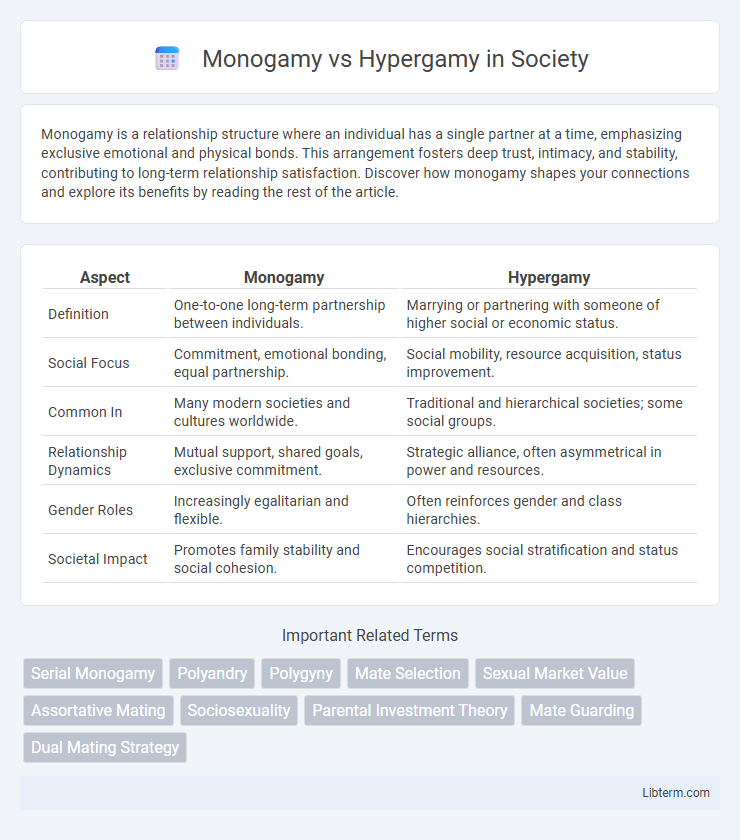Monogamy is a relationship structure where an individual has a single partner at a time, emphasizing exclusive emotional and physical bonds. This arrangement fosters deep trust, intimacy, and stability, contributing to long-term relationship satisfaction. Discover how monogamy shapes your connections and explore its benefits by reading the rest of the article.
Table of Comparison
| Aspect | Monogamy | Hypergamy |
|---|---|---|
| Definition | One-to-one long-term partnership between individuals. | Marrying or partnering with someone of higher social or economic status. |
| Social Focus | Commitment, emotional bonding, equal partnership. | Social mobility, resource acquisition, status improvement. |
| Common In | Many modern societies and cultures worldwide. | Traditional and hierarchical societies; some social groups. |
| Relationship Dynamics | Mutual support, shared goals, exclusive commitment. | Strategic alliance, often asymmetrical in power and resources. |
| Gender Roles | Increasingly egalitarian and flexible. | Often reinforces gender and class hierarchies. |
| Societal Impact | Promotes family stability and social cohesion. | Encourages social stratification and status competition. |
Defining Monogamy and Hypergamy
Monogamy refers to a relationship structure where an individual has one exclusive partner at a time, emphasizing emotional and sexual exclusivity. Hypergamy is the social practice or desire to marry or form a partnership with a person of higher socioeconomic status or greater resources. Understanding these definitions highlights the contrasting motivations behind relationship choices in many cultures.
Historical Evolution of Relationship Patterns
Monogamy, rooted in ancient agrarian societies, evolved as a social contract ensuring parental investment and property inheritance, while hypergamy reflected historical gender and class dynamics where women sought partners of higher socioeconomic status to secure resources and stability. The institution of monogamy became dominant in many cultures due to legal codification and religious influence, shaping societal norms around family and inheritance. Hypergamous practices persisted subtly despite monogamous norms, influencing mate selection and reinforcing social stratification throughout history.
Psychological Motivations Behind Monogamy
Psychological motivations behind monogamy often stem from a deep-seated need for emotional security, trust, and long-term bonding, which supports stable family structures and offspring survival. Monogamous relationships promote oxytocin release, reinforcing attachment and reducing stress, which in turn enhances overall well-being and social cohesion. This contrasts with hypergamy, where mate selection is driven by socio-economic and status-based motivations rather than purely emotional connections.
The Dynamics of Hypergamy in Modern Society
Hypergamy, the practice of seeking a partner of higher social or economic status, shapes modern relationship dynamics by influencing mate selection and social mobility. Economic independence and educational attainment impact hypergamous patterns, often reversing traditional gender roles as women prioritize status and stability. This dynamic fosters both opportunities and tensions in modern partnerships, reflecting evolving societal values and economic realities.
Cultural Influences Shaping Partner Selection
Cultural influences deeply shape partner selection by embedding social norms and expectations that favor either monogamy or hypergamy. In many societies, monogamy is promoted as a cultural ideal emphasizing emotional bonding and equal partnership, while hypergamy reflects hierarchical social structures encouraging individuals, often women, to marry partners with higher socioeconomic status. These cultural frameworks influence mating behaviors, relationship dynamics, and societal acceptance, ultimately guiding individuals in their choice of long-term partners.
Biological and Evolutionary Perspectives
Monogamy in humans is often linked to evolved traits favoring long-term pair bonding, ensuring biparental investment and increased offspring survival. Hypergamy, the tendency to seek partners of higher socioeconomic status, can be explained through evolutionary strategies where women optimize resource acquisition for offspring by selecting mates with superior status or genetic fitness. Biological perspectives highlight hormones such as oxytocin in reinforcing monogamous bonds, while evolutionary theories emphasize differential reproductive strategies between sexes shaped by natural selection pressures.
Social Consequences of Monogamous and Hypergamous Choices
Monogamous relationships often promote social stability by encouraging long-term commitment, mutual support, and reduced partner competition, which can lead to stronger family units and community cohesion. Hypergamous choices, where individuals seek partners of higher social or economic status, can drive social mobility but also increase social stratification and competition, potentially resulting in unequal power dynamics and relationship dissatisfaction. These contrasting patterns influence societal norms and individual well-being by shaping marriage markets, gender roles, and economic disparities within communities.
Gender Roles and Power Structures in Romantic Relationships
Monogamy often reinforces traditional gender roles by promoting a partnership where power is distributed based on societal expectations of masculinity and femininity. Hypergamy, the practice of seeking a partner of higher social or economic status, reinforces power structures by perpetuating economic dependency and social mobility through romantic alliances. These dynamics influence how individuals negotiate control and decision-making within relationships, often maintaining existing gender hierarchies.
The Impact of Technology on Dating and Mating Strategies
Technology has revolutionized dating and mating strategies by expanding social networks and increasing access to potential partners, intensifying competition in both monogamous and hypergamous relationships. Online dating platforms utilize algorithms that emphasize traits aligned with hypergamic preferences, such as socioeconomic status and education, thereby shaping mate selection. This digital shift has challenged traditional monogamous norms by promoting greater choice and fluidity in partner selection, impacting relationship stability and mating behavior.
Monogamy vs Hypergamy: Trends and Future Outlook
Monogamy remains the dominant marital structure globally, supported by legal frameworks and cultural norms, while hypergamy--the practice of marrying into a higher socioeconomic status--continues to influence partner selection, especially in traditional societies. Recent trends show a gradual shift as increasing gender equality and economic independence reduce hypergamic pressures, leading to more diverse relationship dynamics beyond conventional monogamous pairings. Future outlooks suggest that digital dating platforms and evolving social attitudes will further erode rigid hypergamous patterns, potentially redefining norms of monogamy and partner choice in the 21st century.
Monogamy Infographic

 libterm.com
libterm.com